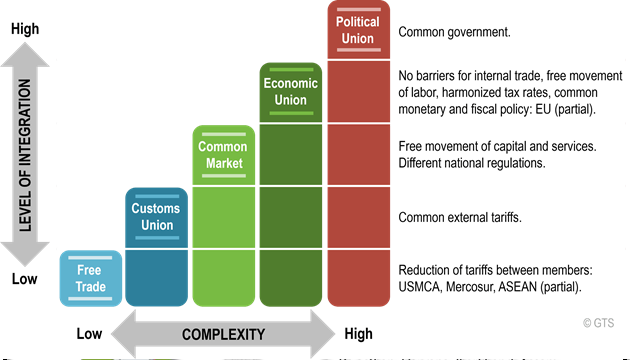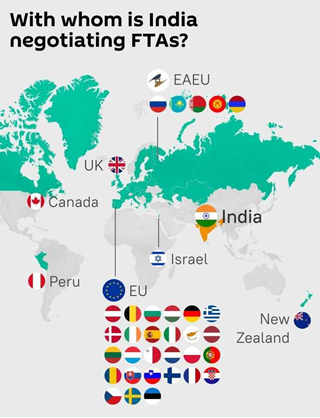TACKLING FTA ATTRACTIONS
Relevance: GS 2 – Bilateral, regional and global groupings and agreements involving India and/or affecting, India’s interests
Why in the news?
- India withdrew from the Regional Comprehensive Economic Partnership (RCEP) negotiations in 2019.
- It took nearly two years for India to restart free trade negotiations with trading partners.
Agreements with India and other countries
- The process resumed with the signing of the India-Mauritius Comprehensive Economic Cooperation and Partnership Agreement (CECPA) in March 2021.
- This was followed by the India-UAE Comprehensive Economic Partnership Agreement (CEPA).
- In 2022, the India-Australia Economic Cooperation and Trade Agreement (ECTA) was signed.
- The India-European Free Trade Association (EFTA) pact was signed in February this year.
- Negotiations are ongoing for trade pacts with Britain, the EU, Oman, and Peru.
India’s Trade Strategy
- Shift from Large Trading Blocs: Avoiding agreements with large trading blocs like RCEP due to high ambition levels and difficulty in finding common ground with multiple partners.
- Focus on Bilateral Arrangements: Emphasis on bilateral agreements where reciprocity is more manageable.
- Diversification Strategy:
- Adopting a diversified approach in a multipolar world.
- Recognizing the stagnation of WTO negotiations.
Expanded Scope in FTAs
- Trade negotiations have evolved from focusing solely on trade in goods to comprehensive agreements covering economic cooperation.
- Includes market access for services, investment, safeguard measures, trade facilitation, technical barriers to trade, and sanitary and phytosanitary measures.
- Comprehensive Evaluation:
- Requires assessing overall balance across multiple negotiating tracks rather than just market access for goods.
- Increased Impact:
- More domestic constituencies are affected and need to be consulted.
- Necessitates more agile institutional mechanisms.
- Emerging Standards:
- New concepts and standards are constantly emerging in each negotiation track.
- Greater ambition with the integration into global value chains.
- Rules of Origin: Trading partners expect rules of origin to be more flexible for both naturally produced goods and manufactured goods.
- Unique Bilateral Negotiations: Each negotiation is unique, but trading partners often demand similar concessions granted to others.
- New concessions to Australia, the UAE, or EFTA may set precedents for other negotiations.
- Higher Tariff Levels: Indian tariffs for industrial goods are higher than those of negotiating partners.
- WTO Compliance:
- FTAs must have substantial trade coverage and predominantly envisage tariff elimination, not just reduction.
- India may need to concede more ground compared to negotiating partners.
Challenges associated with FTAs
- Diverse Industrial Basket:
- India’s diverse industrial base, including a significant MSME segment, presents a challenge in trade negotiations.
- A clever negotiating strategy can leverage this diversity to secure gains in other areas of interest.
- ECTA Example:
- India secured a definitive investment commitment from Switzerland in exchange for tariff concessions in the
- This innovative approach can serve as a model for future negotiations.
- Inverted Duty Rates:
- Creating inverted duty rates compared to general or MFN tariffs is challenging due to India’s tariff structure.
- These challenges are manageable with a coherent strategy.
Strategic Recommendations
- Proactive Approach:
- Identify and articulate offensive trade interests, moving beyond a reactive and defensive stance.
- Engage in broad and meaningful consultations with trade, industry, and other stakeholders to understand real threats and opportunities.
- Craft a well-thought-out negotiating strategy based on shared understanding.
- Onboard Domain Experts:
- Establish a permanent, right-sized institutional mechanism within GoI.
- Bring together domain expertise and diverse skill sets, including:
- Trade data analytics with varying granularity.
- Mapping of export capacity with demand in other markets.
- Identifying domestic supply gaps where easing market access would be beneficial.
- Assessing the likely impact of tariff and non-tariff measures.
- Developing negotiating strategies and legal drafting.
- Institutional Mechanisms:
- GoI is preparing a detailed operating procedure defining the roles and responsibilities of different agencies.
- This step is timely and essential for effective trade negotiation and strategy implementation.
Alternative articles:
https://universalinstitutions.com/challenges-in-india-uk-fta/
https://universalinstitutions.com/united-kingdoms-free-trade-regime/
Mains question
Discuss India’s shift from multilateral trade agreements to bilateral trade negotiations post-RCEP withdrawal, highlighting the challenges and opportunities this strategy presents for India’s diverse industrial and MSME sectors. (250 words)





